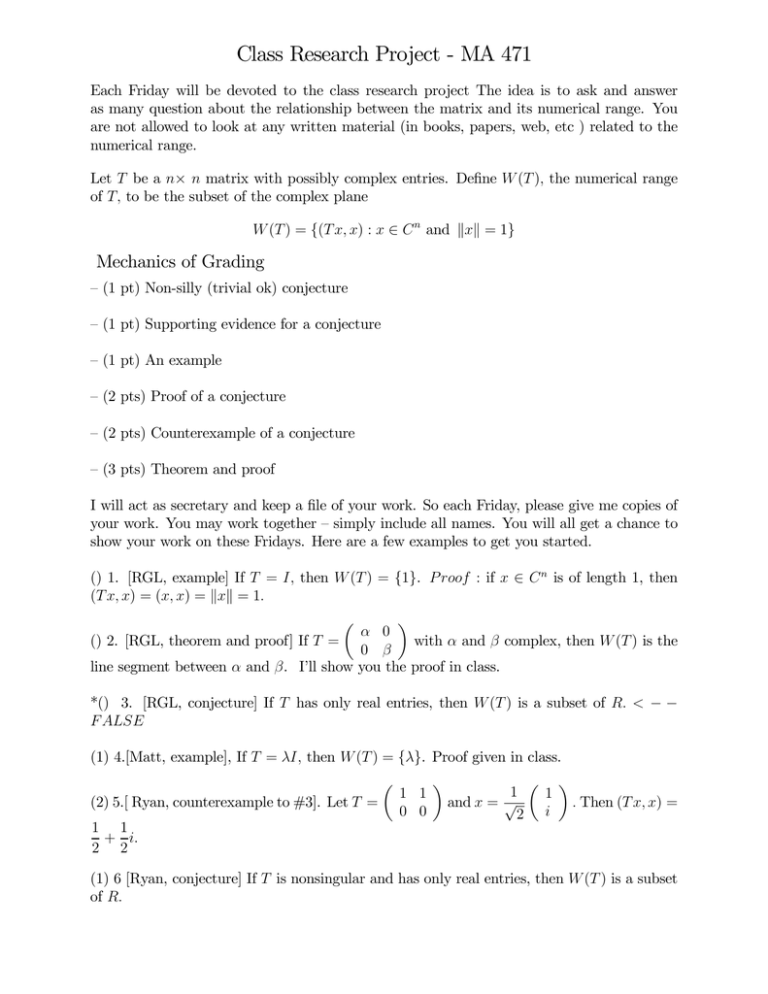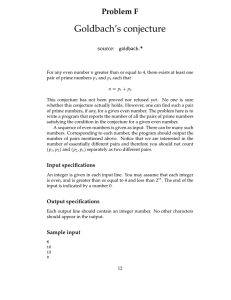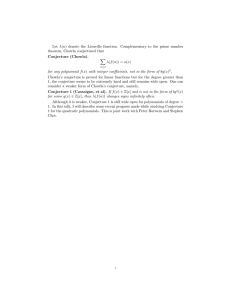Class Research Project - MA 471
advertisement

Class Research Project - MA 471
Each Friday will be devoted to the class research project The idea is to ask and answer
as many question about the relationship between the matrix and its numerical range. You
are not allowed to look at any written material (in books, papers, web, etc ) related to the
numerical range.
Let T be a n× n matrix with possibly complex entries. Define W (T ), the numerical range
of T, to be the subset of the complex plane
W (T ) = {(T x, x) : x ∈ C n and kxk = 1}
Mechanics of Grading
— (1 pt) Non-silly (trivial ok) conjecture
— (1 pt) Supporting evidence for a conjecture
— (1 pt) An example
— (2 pts) Proof of a conjecture
— (2 pts) Counterexample of a conjecture
— (3 pts) Theorem and proof
I will act as secretary and keep a file of your work. So each Friday, please give me copies of
your work. You may work together — simply include all names. You will all get a chance to
show your work on these Fridays. Here are a few examples to get you started.
() 1. [RGL, example] If T = I, then W (T ) = {1}. P roof : if x ∈ C n is of length 1, then
(T x, x) = (x, x) = kxk = 1.
µ
¶
α 0
() 2. [RGL, theorem and proof] If T =
with α and β complex, then W (T ) is the
0 β
line segment between α and β. I’ll show you the proof in class.
*() 3. [RGL, conjecture] If T has only real entries, then W (T ) is a subset of R. < − −
F ALSE
(1) 4.[Matt, example], If T = λI, then W (T ) = {λ}. Proof given in class.
(2) 5.[ Ryan, counterexample to #3]. Let T =
1 1
+ i.
2 2
µ
1 1
0 0
¶
1
and x = √
2
µ
1
i
¶
. Then (T x, x) =
(1) 6 [Ryan, conjecture] If T is nonsingular and has only real entries, then W (T ) is a subset
of R.
(1) 7 [Ryan, conjecture] If all eigenvalues of T are real, the W (T ) is a subset of R.
(1) 8 [Ryan, conjecture and eg] If T is symmetric, then W (T ) is a subset of R.
(1 ) 9 [Ryan, thm and proof] If T is positive definite, then W (T ) is contained in R+ .
(3) 10 [Ryan and Guy]. σ(T ) ⊂ W (T ).
(3) 11 [Michael and Justin, thm]. If T is singular, then 0 ∈ W (T ).
* (1) 12 [Michael and Justin, conjecture]. If 0 ∈ W (T ), then T is singular. < −− FALSE
(1) 13 [Adam and Gabriel, example] If each entry of an n × n matrix is α, then nα ∈ W (T ).
(1) 14 [ Dan, Jay,conjecture]. If T is a n × n diagonal matrix, then W (T ) is the convex hull
of the diagonal elements. <-TRUE
(2) 15 [Guy, proof of 14]
(3 ) 16 [Guy, thm] W (T ∗ ) = W (T ).
(2) 17 [Guy and Ryan, counterexample to 12] Let T =
µ
1 0
0 −1
¶
.
(2) 18. [Guy,conjecture and examples] If Q is orthonormal, then W (Q) is the convex hull of
the eigenvalues of Q.
(1) 19 [Guy, conjecture] W (T ) is the convex hull of eigenvalues if and only if T = QDQ∗
where D is diagonal and Q is unitary.
(1) 20 [Guy, conjecture] W (T ) is always convex.
(1) 21 [Guy, conjecture] If T is 2 × 2, then W (T ) is an ellipse (possibly degenerate).
(3) 22 [Matt, Thm] If T = aM + bI, then W (T ) = aW (M) + b.
(1) 23 [Guy, conjecture] Let P (S) denote the perimeter of the convex hull of a set S (If S
consists of two points {α, β} , then define P ({α, β}) = 2 |α − β|). If Λ is the set of eigenvalues
for a matrix T, there exists α ≥ 0 such that W (T ) = {z : P (Λ ∪ {z} ≤ P (Λ) + α} .
(1) 24 [Guy, conjecture ] Let T = λI + A, where A is the matrix with all zeros except in the
upper right hand corner where there is α. Then W (T ) is a circle with center λ and radius
α
. Note: Guy offered a proof but I want more details.
2
(1) 25 [Guy, conjecture] The boundary of W (T ) can be obtained by applying the map
f (x) = x∗ T x to a great circle on the unit sphere.
(3) 26 [Kellan, thm] If A = U BU ∗ , then W (A) = W (B). Proof given in class - everybody
should be able to do this!!
(3) 27 [Justin and Mike, thm ] If T is unitary, W (T ) is contained in the unit disk. This was
proved in class. After the proof, the discussion led to a proof that W (T ) will actually equal
the convex hull of the eigenvalues of T . Note that after this week’s hw, you will see that the
eigenvalues all have modulus 1.
(1) 28 [Justin and Mike, example ] An example was given to show that the numerical range
of a real orthogonal matrix is not necessarily a subset of [−1, 1].
() 29 [class] It was noted previously that W (T ) is a compact (hence closed and bounded)
subset of the complex plane. Reason; W (T ) is the continuous image of a compact set in C n .
(3) 30 [Dan and Jay] W (T ) is bounded by kT k . This follows from the Cauchy-Schwartz
inequality and properties of the norm of a matrix.
(1) 31 [Dan and Jay,Conjecture] Let B be a submatrix of A, then W (B) ⊂ W (A). Note Need to be more specific about "submatrix". They mentioned that B appears as a "block"
in the matrix A. Will this be true for any block? Also can this stated in terms of subspaces
rather than subblocks of the matrix/
(1) 32 [Dan and Jay,Conjecture] Try to think of W as a mapping from the space of matrices
into somthing (collection of sets or a product space) and then look at properties of the map.
(3) 33 [Dan , Jay,Justin,Mike, thm] If T is Hermitian, then W (T ) ⊂ R.
(3) 34 [Justin, Mike,thm] If T is skew-Hermitian (ie T ∗ = −T ), then W (T ) ⊂ imaginary
axis
(1) 35 [Dan and Jay,Conjecture] Is the size (or location) of W (T ) related to the conditioning
of the matrix. Are the singular values of T related to W (T )?
(1) 36 [Matt,Conjecture] If 2 matrices have the same numerical range, are the matrices
unitarily equivalent?
(1) 37 [Matt,Conjecture] (related to 36). If W (T ) = αW (M) + β, then T = αA + βI where
A = U ∗ MU for some unitary U.
(3) 38 [Class, Thm] If T is Hermitian (ie T ∗ = T ), and W (T ) = {0}, then T is the zero
matrix. This was proved in the HW.
(3) 39 [Ryan, thm] For any matrix T, if W (T ) = {0}, then T is the zero matrix. Pf: Write
T = H + iK where H and K are Hermitian. Then use #38.
(3) 40 [Class, thm]. If W (T ) ⊂ R, then T is Hermitian. Pf; Again, write T = H + iK where
H and K are Hermitian.
(3) 41 [Class, thm].If W (T ) ⊂ R, then W (T ) is a connected line segment.
(3) 42 [Class, thm].If W (T ) is equal to any connected line segment in C, then T is normal.
In fact, T = αA + βI where A is Hermitian.
(1) 43 [Ryan, conjecture](related to #16) If the entries of T are purely imaginary, then W (T )
is symmetric with respect to the imaginary axis. Have we proved that if T contains only real
entries, then W (T ) is symmetric to the real axis?




